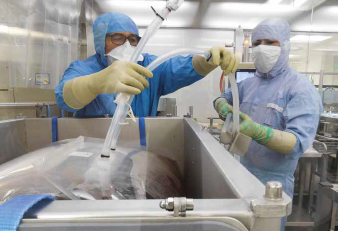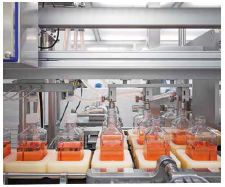Home > Article: pH Control in Tissue Culture with Biological Buffers
pH Control in Tissue Culture with Biological Buffers
A 'physiological' or balanced salt solution is present in all tissue culture medium.
The essential roles of this salt solution in the medium are to keep the pH balanced, maintain optimal osmotic pressure, and generate energy. When a nutritionally balanced tissue culture media is buffered at a pH in the range of 7.2–7.4, animal cell development is typically excellent. The pKa of the selected buffer should be as near to the needed pH as feasible to perform well.
Sodium bicarbonate is the most used buffer in tissue culture medium. This buffer, however, has two significant drawbacks:
At 37°C, sodium bicarbonate has a pKa of 6.3, resulting in poor buffering over the physiological pH range.
Alkalinity rises when carbon dioxide is released into the atmosphere, and the quantity of hydroxyl ions created rises in proportion to the amount of sodium bicarbonate added to the medium. This may be controlled by providing carbon dioxide to the environment artificially and keeping the gas from exiting the liquid, lowering the hydroxyl ion concentration in solution.
There are two types of balanced salt solutions:
Those designed to equilibrate with air in a closed system at a low sodium bicarbonate concentration (Hank's Balanced Salt Solution), and those designed to equilibrate with a gaseous phase containing approximately 5% CO 2 at a higher sodium bicarbonate concentration (Earle's Balanced Salt Solution Cat. No: 3-01F00-I).

Earle's Balanced Salt Solution is a superior solution since it includes more sodium bicarbonate, but it is more difficult to use because it needs the culture medium to generate a particular gaseous combination of 5% CO 2 and 95% air. At typical incubation temperatures, if this technique is not followed, the pH will rise quickly. The medium's purple tint signals that the pH has increased, preventing cell development. Another option is to employ a medium that generates adequate buffering capacity but does not need 5% CO 2.
This can be accomplished in some situations by using a medium containing Earle's salts but with a sodium bicarbonate content of 0.85 g/liter. Leibovitz took a very different approach (1963). He used free base amino acids as buffers, deleted sodium bicarbonate, used galactose instead of glucose, and added pyruvate. His L-15 medium has a pH of roughly 7.8, which is higher than most other media. The pH will not rise any more since there is no generation of CO 2. This medium allows cells to grow in open culture containers regardless of the amount of CO 2 present in the air.
In recent years, efforts have been undertaken to determine the best buffer.

HEPES buffer, which was initially introduced by Good et al., is the most often used alternative to bicarbonate (1966).It works as a zwitterion and has outperformed traditional buffers in biological comparisons, such as cell-free preparations. It has a number of characteristics that make it an excellent buffer for tissue culture medium, the most important of which is that it does not require an enriched environment to maintain the correct pH. At 0 C, HEPES is soluble to the limit of 2.25 M and does not bind divalent cat ions. Note that, due to the DpKa / °C of 20.014, the pH value in a HEPES buffered medium varies inversely with the medium's temperature.
This can be accomplished in some situations by using a medium containing Earle's salts but with a sodium bicarbonate content of 0.85 g/liter. Leibovitz took a very different approach (1963). He used free base amino acids as buffers, deleted sodium bicarbonate, used galactose instead of glucose, and added pyruvate. His L-15 medium has a pH of roughly 7.8, which is higher than most other media. The pH will not rise any more since there is no generation of CO 2. This medium allows cells to grow in open culture containers regardless of the amount of CO 2 present in the air.
In recent years, efforts have been undertaken to determine the best buffer.
HEPES buffer, which was initially introduced by Good et al., is the most often used alternative to bicarbonate (1966).It works as a zwitterion and has outperformed traditional buffers in biological comparisons, such as cell-free preparations. It has a number of characteristics that make it an excellent buffer for tissue culture medium, the most important of which is that it does not require an enriched environment to maintain the correct pH. At 0 C, HEPES is soluble to the limit of 2.25 M and does not bind divalent cat ions. Note that, due to the DpKa / °C of 20.014, the pH value in a HEPES buffered medium varies inversely with the medium's temperature.
Contact us today to discuss the most effective ways for your pH Control or browse our buffers page for more information! Our team will be happy to help you find the right solution for your application.
